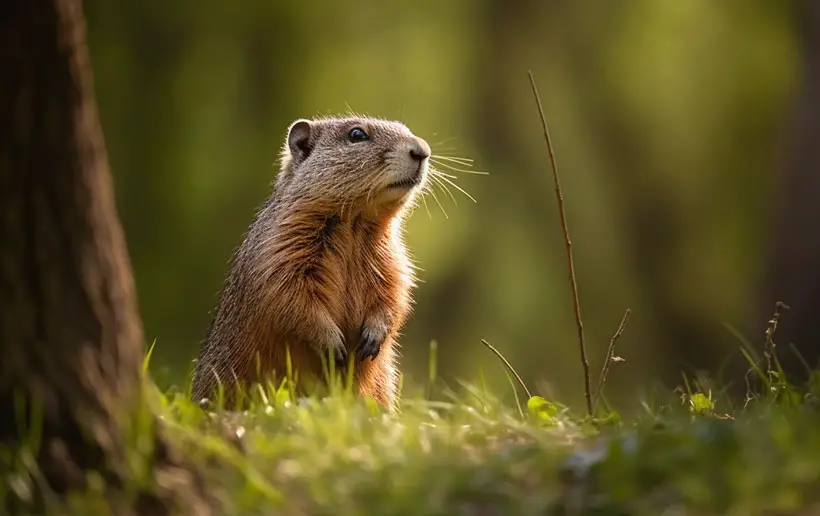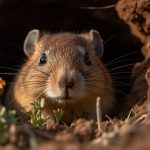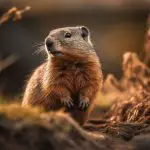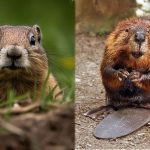Can Gophers Climb Trees: Understanding Behaviour and Prevention
Gophers are burrowing rodents that cause havoc beneath the earth, which can seriously harm crops, lawns, and gardens. Although their underground activity is well documented, it is disputed if they can climb trees. So, can gophers climb trees?
Yes, they can, to some extent. Gophers are ground animals; where they dig elaborate tunnel networks for security, food, and housing. They are also known to build dirt mounds on the ground. Gophers may climb tiny bushes and shrubs in addition to their digging activities to reach food sources.
Effective pest management calls for a knowledge of gophers’ climbing capabilities. Traps and repellents, common gopher control measures, might not be sufficient to keep them out. Hence, to safeguard your plants and crops from these elusive rodents, let us take you to wildlife management practices.
Gopher Behavior: Burrowing and Foraging Habits
Gophers have a reputation for having enormous tunnel networks and acting destructively, which can harm gardens, lawn maintenance, and crops. For gopher management and control to be effective, this pest must be understood from their wildlife behavior.

Burrowing Habits
A crucial component of gopher activity is digging, which helps them adapt to life underground. They create huge tunneling networks that may reach depths of several meters and lengths of up to 200 meters. These pests use these tunnels to travel between different locations as well as to live.
Foraging Habits
Gophers eat a variety of plants and are largely herbivorous. They frequently drag entire plants below to devour them and prefer to feed on roots, bulbs, and tubers. Moreover, they are known to chew the bark of trees and shrubs, which can harm or even kill the plants.

On the other hand, gophers are active all year long, and their foraging techniques can have a big influence on the health and survival of plants. It is crucial to take precautions to safeguard plants against gophers’ foraging activity in regions where they are prevalent.
Types of Vegetation Preferred by Gophers
Gophers will eat a variety of plants since they are not picky about the vegetation they eat. Nonetheless, they do favor particular kinds of plants, such as:
- Grass – Gophers have been known to eat grass roots, which can harm lawns and pastureland
- Legumes – Gophers will consume the roots of legume plants, which may significantly reduce crop production
- Shrubs – They will feed on the bark of shrubs, which can cause damage or even death to the plants
- Trees– Gophers chew the bark of trees, which can harm or even kill the trees. Fruit plants and nut trees are their favorites

Interactions with Different Plant Species
Depending on how they forage and the properties of the plants, gophers can interact differently with various plant species. While certain plants can be more sensitive to gopher damage than others, some might be more resilient. For instance:
- Native plants – Gophers may have coevolved with certain native plant species like California fuchsia (Epilobium canum), Yarrow (Achillea millefolium), Penstemon (Penstemon spp.), California poppy (Eschscholzia californica), Toyon (Heteromeles arbutifolia). Which may be more resistant to their foraging behavior.
- Non-native plants – As non-native plants do not have the same defenses as native plants, they might be more susceptible to gopher damage.
Suppose a homeowner in California decides to plant a non-native species of ornamental plant in their backyard, such as a Japanese maple tree. This tree species is not native to California and may not have evolved the same defenses against local pests and wildlife as native plants in the area.
- Plant size – Because smaller plants are simpler to pull out from the ground and eat, gophers may target them more frequently.
- Plant placement – Because gophers may quickly access plants that are close to their tunnel systems, these plants may be more susceptible to harm.
Gopher Climbing Behavior: Factors Affecting Their Ability to Climb Objects
Although gophers are more commonly recognized for their digging skills, they can somewhat climb fences, trees, and other structures. We shall examine the numerous aspects of this animal climbing behavior, including their species, age, and the surface texture they are climbing.
- Climbing fences: Fences are one of the most typical items that gophers climb. They can climb both wooden and metal fences by grabbing hold of the material with their claws and pulling themselves up.

Gophers can simply leap down to the other side once they reach the top of the barrier. But they are not likely to be able to climb a 90-degree angled fence.
- Climbing trees: Although they are not as adept as squirrels or other arboreal rodents, gophers can climb trees. They often climb trees to reach food supplies hidden in the branches, including nuts or fruits. Gophers are not known to climb very high; they frequently stay on the tree’s lower branches.
Overview of Factors that Affect Gopher Climbing Behavior
A gopher’s capacity to climb things can be influenced by several circumstances. Their climbing capacity may depend on their species and age.
- Age: For example, some species of gophers may be better climbers than others. Consequently, younger gophers may be more agile and able to climb higher than older individuals.
- The texture of the Surface: The texture of the surface that the gopher is climbing is also an important factor. Rough or textured surfaces are easier for gophers to climb than smooth ones. Also, they find it more challenging to climb smooth surfaces like metal or glass.
- Size and Shape of Tree: The gopher’s capacity to climb may also depend on the size and shape of the thing they are climbing. Gophers are better able to climb objects that are relatively straight and vertically angled, as opposed to those that are curved.
Implications for Pest Control: Understanding Gopher Climbing Behavior
We’ll now talk about how gopher climbing behavior affects pest control. Also, the influences of how well certain control measures, such as fences or obstacles, work.

Gopher Climbing Behavior and Its Implications
The tendency of gophers to climb presents a serious problem for conventional garden pest control methods like fences or obstacles. The type of material used and the barrier’s height significantly impact the effectiveness of fencing or barriers in gopher control.
For instance, gophers may scale wire fences unless the mesh is buried at least 2 feet beneath the surface and rises at least 18 inches above it. Barriers made of plastic or metal may be effective. But they must be buried deep enough to prevent gophers from burrowing under them.
Detecting Gopher Activity and Assessing Infestation Levels
So how to tell if you have a gopher infestation? Let’s see:
- Look for Dirt Mounds: You can check for mounds of dirt or plants that are often shaped like a crescent or horseshoe to spot gopher activity.
- Poke a Stick: Usually 2 to 3 inches in diameter, gopher tunnels can be found by poking a stick or shovel into the ground.
- Uprooter Plants: Plants that have been uprooted or have had their roots harmed may also be visible. You can use traps or bait, or natural deterrents to catch or kill gophers if you suspect them of being active.
- Monitoring: Monitoring gopher activity over time is necessary to determine the extent of the infestation. Gophers can multiply fast, so even a tiny infestation can grow into a serious issue.
Management Strategies for Controlling Gopher Infestations
Trapping, baiting, and natural pest control approaches are effective management techniques for eradicating gopher infestations.

Trapping
Gopher population management frequently involves trapping. There are many different kinds of traps for gopher species, such as box traps, tunnel traps, and snap traps.
- Box Traps: Box traps are made to catch gophers alive so that they may be moved to another site.
- Tunnel Traps: Tunnel traps are placed in active tunnels, where the gopher is caught and killed.
- Snap Traps: Snap traps are made to swiftly and humanely dispatch gophers.
Baiting
Another popular strategy for managing gopher infestations is baiting. There are many different formulations of poison baits, including pellets, blocks, and liquids.
You can buy baits from stores. The bait is then positioned in gopher burrow systems or active tunnels, where the rodents will eat it.
Natural Technics
Gopher populations can be managed using natural pest management techniques. One such method is the use of predator-prey interactions, such as domestic cats or birds of prey, to hunt and kill.
The use of natural repellents like castor oil or garlic to deter gophers and stop them from eating plants is another technique.
Preventing Gopher Infestations
There are several precautions gardeners may take to minimize gopher infestations and lessen the damage these rodents wreak.

Physical Barriers
Putting physical barriers around the garden area is a useful tactic. A Garden fence falls under this category. It can be constructed of chicken wire or wire mesh and should reach at least one foot below ground to deter gophers from tunneling below.
Clay Soil
Gophers love loose, permeable soil. Therefore adding clay soil or compacting the soil may discourage them from inhabiting an area.
Gopher Resistant Plants
Gopher-resistant plants, such as alliums, are another option for companion planting. Garlic spray and other natural pest deterrents like castor oil can also work well.
Clean Garden
Removing plant debris and keeping the garden area clean can help to prevent gophers from finding hiding spots.
If you’re curious about whether gophers can climb trees, be sure to check out our article on can gophers climb trees for information on the physical abilities of gophers and whether they are capable of scaling trees. Additionally, if you’re wondering why gophers make mounds of dirt, our article on why do gophers make mounds provides insights into the behavioral and ecological reasons behind this common behavior. Finally, if you’re interested in gopher social behavior, our article on how many gophers live together explores the social dynamics of these animals and how they interact with each other in the wild. Our piece on why do gophers make mounds offers insights into the behavioral and ecological reasons behind this common behavior, while our article on how many gophers live together provides information on the social dynamics of these animals.FAQs
Many people have questions about these pests. Some of the most asked questions are answered below.
Can gophers climb trees?
Gophers can climb trees but they are not good climbers. They lack the physical attributes required to climb trees because they are generally ground-dwelling animals, not tree-climbing animals. Mostly gophers can climb up to 1 or 2 feet off a tree.
How do I know if I have a gopher infestation?
Look for indications such as dirt mounds in your lawn or garden, chewed plant roots, and tunnels or holes in the ground. This will help you to discover whether you have a gopher infestation. Due to gophers’ tendency to eat plant roots, you can also observe drooping or dead plants.
Conclusion
So we know that even though gophers are primarily ground-dwelling, they are capable climbers and can climb small fences and shrubs. It’s important to understand gopher behavior and climbing ability if you want to manage animals and use pest control effectively.
Understanding gopher behavior, such as their climbing ability, can help develop more targeted and effective pest control methods. Effective pest control can also benefit the wider ecosystem by reducing the impact of gophers on other plant and animal species too.
More research is needed on these climbing animals and their behavior to develop more targeted pest control methods. Research into gophers’ larger ecological consequences and their control strategies is also necessary to comprehend the role they play in ecosystems.




